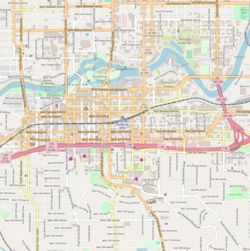PotlatchDeltic Corporation is an American diversified forest products company based in Spokane, Washington.

Fort George Wright is a land area in the northwest United States, located in Spokane, Washington's West Hills neighborhood. It is named after General George Wright, who had been stationed in the area.
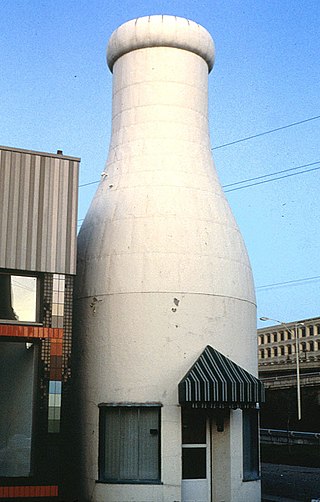
The Benewah Milk Bottle is a landmark in Spokane, Washington. Listed in the National Register of Historic Places, there are two constructed milk bottle-shaped buildings in the Spokane area, which accompanied a successful dairy operation's stores. One of the buildings is located on South Cedar Street in Downtown Spokane, while the other is located two miles north in the Garland Historical District of North Hill.

The Riverfront Park Carrousel, also known as the Looff Carrousel and the Natatorium Park Carousel, is a carousel in Spokane, Washington built in 1909 by Charles I. D. Looff as a gift for Looff's daughter Emma Vogel and her husband Louis Vogel, who owned Natatorium Park in Spokane. It remained at Natatorium Park until 1968 when the park closed. The carousel was then relocated to its present location at Riverfront Park in 1975 where it continues to operate. It was added to the National Register of Historic Places on September 19, 1977.
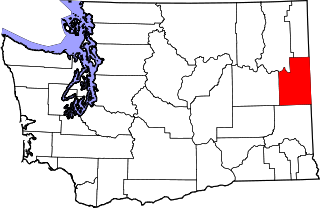
This is a list of the National Register of Historic Places listings in Spokane County, Washington.

This is a list of the National Register of Historic Places listings in Ada County, Idaho.
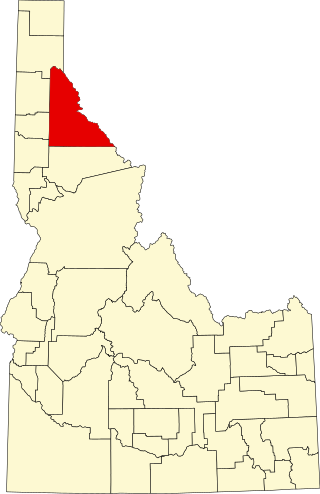
This is a list of the National Register of Historic Places listings in Shoshone County, Idaho.

The City Hall of Moscow, Idaho, formerly known as the Moscow Post Office and Courthouse and Moscow Federal Building, was built 113 years ago in 1911. Its red brick with ivory terracotta trim reflects Late Victorian and Eclectic architecture.
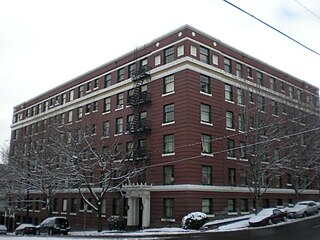
Albert Held was an American architect. He was born in New Ulm, Minnesota on March 25, 1866, and studied for two years at the University of Minnesota. He first worked as a draftsman

Knickerbocker is a historic Beaux Arts building in the Cliff/Cannon neighborhood of Spokane, Washington. It was designed by architect Albert Held and was built in 1911. It was listed on the National Register of Historic Places in 1987. The building is also listed on the Spokane Register of Historic Places, under the name Knickerbocker Apartments.

The San Marco is a historic Renaissance Revival apartment building in Downtown, Spokane, Washington that was built in 1904. It was designed by architect Albert Held. San Marco was listed on the U.S. National Register of Historic Places in 1987. It is also listed on the NRHP as a contributing property in the Riverside Avenue Historic District.
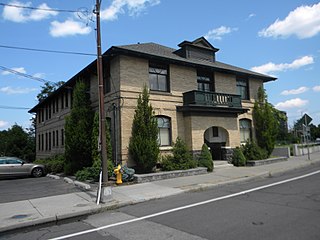
Amman or Ammann, in the Browne's Addition neighborhood of Spokane, Washington is a building constructed in 1904. It was designed by architect Albert Held. The building was listed on the U.S. National Register of Historic Places in 1987. Although the National Register of Historic Places list the property under the name Amman the Spokane Register of Historic Places lists the building as Ammann.
James H. Nave was an American architect based in Lewiston, Idaho. He designed a number of works which are listed on the National Register of Historic Places (NRHP) for their architecture.

The Breslin is a historic six-story building in the Cliff/Cannon neighborhood of Spokane, Washington. It was designed by architect Albert Held in the Classical Revival style, and built in 1910 by W.H. Stanley with "Tenino sandstone, press red brick and cream-colored terra cotta" at a cost of $100,000.
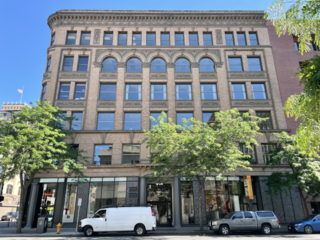
The Empire State Building, also known as the Great Western Savings and Loan Building, is a historic building in Downtown, Spokane, Washington. It was designed by architect John K. Dow, and built in 1899 for Charles Sweeny, an investor who had served under Union Army General George Armstrong Custer during the American Civil War of 1861–1865. It has been listed on the National Register of Historic Places since August 18, 1977.

The Eldridge Building is a historic building in Spokane, Washington. It was designed by architect Gustav Albin Pehrson, and built in 1925. It has been listed on the National Register of Historic Places (NRHP) since November 12, 1992. It is one of three historic buildings listed on the NRHP at the intersection of First Avenue and Cedar Street. To the west across Cedar is the Grand Coulee building and to the northwest, kitty-corner from the Eldridge Building, is the former Carnegie Library.

The Kemp & Hebert Building, also known as the Liberty Furniture Store, is a historic four-story building in Spokane, Washington. It was designed by Alfred D. Jones in the Classical Revival style, and built in 1908 as a store for Kemp & Hebert, a dry goods company co-founded by Spokane businessmen Charles John Kemp (1857–1914) and Henry H. Hebert (1866–1941) in 1892.
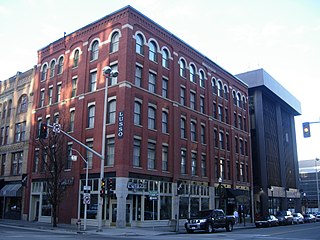
The Whitten Block is a historic five-story building in Spokane, Washington. It was designed by architect Lorenzo M. Boardman, and built in 1890 for investor Leydford B. Whitten at a cost of $40,000. Tenants included a dry goods store, a flower shop, a shoe repair store, a candy store as well as clothing stores.

Spokane and its neighborhoods contain a patchwork of architectural styles that give them a distinct identity and illustrate the changes throughout the city's history. Spokane has a rich architectural history for a western city of its size and much of it is a product of its circumstances at the turn of the 20th century when as a rapidly growing city, the Great Fire of 1889 destroyed 32 blocks of the city center which was quickly rebuilt in a more grand fashion by a community flush with money coming from regional mining districts. Many of the architects that found work in the city and building on the blank slate of the downtown commercial district became highly esteemed architects such as Kirtland Cutter, who has been credited with giving the city a distinctive character. In particular, the city has a high concentration of Romanesque Revival style institutional and commercial buildings and American Craftsman bungalow residences. The architecture of Spokane gained national recognition in industry publications in the early 20th century.

